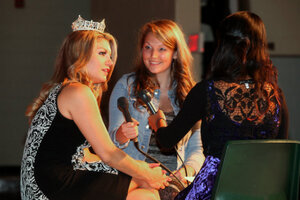Ask Miss America contestants about Syria
The Miss America pageant’s defenders argue it 'empowers' women rather than demeans them. It’s time we put that claim to the test by asking them to speak their minds on controversial issues like Syria, especially as some contestants parlay their pageant experience into politics.

Gabrielle Hughes, center, and Samantha Phommalyla (right), interview Miss America, Mallory Hagan, left, in a Absegami High School media class on Monday Sept. 9, 2013 in Galloway, N.J. Op-ed contributor Jonathan Zimmerman writes: 'If we wish to find out which women are intellectually qualified for this honor [of Miss America], we need to honor their intellects.'
Vernon Ogrodnek/The Press of Atlantic City/AP
New York
So here’s a question that every finalist should face in this Sunday’s “Miss America” competition in Atlantic City: Should the United States strike Syria?
I’m serious. For years, the pageant’s defenders have been saying that it “empowers” women rather than demeans them. So it’s time we put that claim to the test, by asking contestants to speak to one of our most urgent political issues.
That’s probably not the kind of controversy envisioned by the organizers of Miss America, which is returning to the Jersey Shore after a nearly eight-year hiatus in Las Vegas. But pageant officials can’t have it both ways. If they want Miss America to be more than a beauty contest, they need to challenge the contestants' minds. Anything less will patronize the same women that the Miss America pageant puts on a pedestal.
The first few Miss America competitions didn’t try to look like anything but a battle for the best looks. Starting as a “bathing beauty” contest in 1921, the pageant was sponsored by hoteliers who wanted to keep tourists in Atlantic City beyond Labor Day. What better way than to parade attractive young women up and down the boardwalk, several weeks after the official end of summer?
Only eight women entered the 1921 pageant. But 57 competed the next year, luring more than a quarter-million spectators. “As an advertising campaign, the Pageant was a masterpiece,” declared the Pennsylvania Railroad, which saw its own ticket sales skyrocket as tourists swarmed to Atlantic City.
But the pageant came under fire from religious conservatives, in New Jersey and around the country. “The danger lies in taking girls of tender years and robing them in attire that transgresses the limit of morality,” one church group resolved in 1923. “The saddest feature of the affair is the willingness of a few businessmen to profiteer on the virtues of those tender years.”
So Atlantic City’s town fathers discontinued the pageant in 1927. And when they brought it back, in the mid-1930s, they took pains to emphasize its respectable character. Contestants were prohibited from entering any establishment where alcohol was served. They were also warned that they would be disqualified if they were seen alone with men – including their own fathers.
To demonstrate that the pageant wasn’t just about beauty, meanwhile, officials introduced the talent competition. And in 1945, they began to award educational scholarships. Today, Miss America boasts that its local, state, and national competitions represent the biggest scholarship program for women in the world.
But the pageant would come under attack again in the 1960s, this time from feminists. Protesters burned bras, girdles, and pornographic magazines at the 1968 competition, where they also bestowed the title of Miss America on a sheep. Demonstrations would continue into the mid-1970s, when a New York Times headline captured the essence of the clash: “Miss America Faces Ms.”
In response, the pageant tried yet again to leaven its glitz with more substance. Starting in 1990, every contestant has chosen her own “platform” issue. But most of these matters are relatively non-controversial ones, like eating disorders or bullying; they don’t require you to frame a tough position or defend it against naysayers.
That makes things way too easy for the contestants, who are starting to parlay their Miss America experience into, yes, electoral politics. Miss America 2002, Republican Erika Harold of Illinois, is now making her second bid for a seat in Congress. State pageant winners have also run for office in Indiana, Vermont, and Hawaii. And don’t forget the Miss Alaska runner-up who ended up on the presidential ticket in 2008: Sarah Palin.
Do these examples show that the pageant gives women a leg up, instead of simply showcasing their long legs? Perhaps. Or maybe our modern political campaigns have become beauty pageants in their own right, melding vapid sound-bites and tweets with really good makeup and hair.
If the Miss America pageant wanted to prepare women for real political participation and leadership, it would make them field hard questions – about Syria, immigration, debt, and everything else. Instead, contestants are typically treated to softballs like “What is a good citizen?” and “What does America mean to you?”
There are exceptions, of course. At the last Miss America competition in Vegas, shortly after the Newtown tragedy, one woman was asked whether schools should have armed guards and whether this would make them safer.
“I don’t think the proper way to fight violence is with violence. I think the proper way is to educate people on guns and the ways we can use them properly,” replied New York’s Mallory Hagan. “We can lock them [guns] up, we can have gun safety classes, we can have a longer waiting period.”
The comment raised hackles among gun-rights advocates. But it also helped win the Miss America crown for Ms. Hagan, whose pointed response separated her from the rest of the pack. If we wish to find out which women are intellectually qualified for this honor, we need to honor their intellects. Or, we can just go back to talking about how awesome they look in bathing suits.
Jonathan Zimmerman is a professor of history and education at New York University. He is the author of “Small Wonder: The Little Red Schoolhouse in History and Memory” (Yale University Press).

